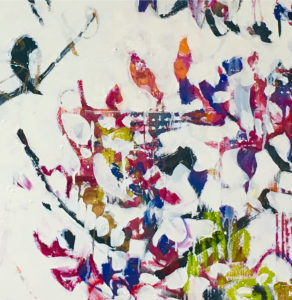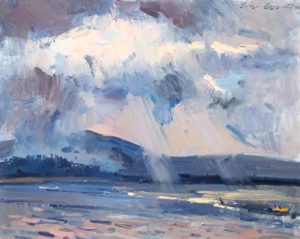Dear Artist,
It’s warm and muggy beside this froggy pond. I’m the shiny guy wearing the Deep Forest Off. Nearby, an Oregon towhee rummages in the undergrowth. In the distance, a barred owl is being harassed by resident robins. With no immediate obligations and practically no guilt, I’m moving slower than a spotted slug. After years of jumping directly into painting, these days I’ve been casually drawing things out with a soft pencil. Also, trying to please myself, I’m judiciously glazing work in progress with red oxide — a colour I’ve previously found unpleasant.
Funnily, Irene Feeney of Roscommon, Ireland, just wrote, “I’m one who struggles to be pleased. I’m also speedy; I complete a painting in a day where another person might take weeks. It may be that my attention to detail is not so accurate, but I like to work fast. I find it hard to work at one section; I look at the whole painting as I work. Maybe this is something I need to harness. Do you think this may be my downfall?”
Thanks, Irene. I’m not going to comment on your downfall, but I do have a few thoughts on fast and slow. The virtue of a painting may not be accuracy, but feeling. Further, taking your time to feel what you’re painting is more important than speedy delivery. In both feeling and execution, some folks are naturally faster than others. That you have identified yourself as one of the speedy is just great.
Speedy painters tend to do fresher work than pokey ones. On the other hand, they are also responsible for a lot of the messy stuff you see out there. Just for the sake of change, you might try forcibly slowing down. It’s the “extra time” concept. It has something to do with gently living in the present and focusing on the potential of the work at hand. It can be done at the edge of a froggy pond or in a studio sanctuary. One needs to become aware of the relative time between stroking and contemplating. “Look three times, think twice, paint once,” is a time-honoured shibboleth. Here’s the ploy: Make a work of art that looks like it was done freshly and quickly — but take a long time to do it.
Best regards,
Robert
PS: “Hasten slowly.” (Augustus Caesar)
“Wait for that wisest of all counselors; Time.” (Pericles)
Esoterica: Many painters feel they have to work furiously to catch the passion. The Russian-American Impressionist Sergei Bongart used to say, “I have to get it out quick or I cool off.” But this came after a lifetime of polishing his craft. Who knows how he was when he started out. Fact is, many mature artists re-adopt the hesitant approach of their youth. Composer Igor Stravinsky said, “Hurry? I never hurry. I have no time to hurry.” Watching that spotted slug streak down the pathway I’m thinking of Lao Tzu: “Nature does not hurry, yet everything is accomplished.”
This letter was originally published as “Slow down to speed up” on August 3, 2012.
Have you considered a Premium Artist Listing? With each letter, an artist is featured at the bottom of this page. The Premium Artist Listings are a means of connecting artist subscribers through their work. Proceeds from each listing contribute to the production of The Painter’s Keys.
“Be here now.” (Ram Dass)
Featured Workshop
 Join Ellie Harold for “Intuitive Painting: Permission to Paint Expressively,” designed especially for mature women artists of all skill levels who wish to explore this medium for soulful exploration. The retreat provides attractive accommodations (your own room!) along with lightly structured activities for centering, relaxation and low stress art-making. You’ll have plenty of free time to muse, paint, write and reflect while enjoying the colors, textures and flavors of San Miguel. This Retreat has the potential to transform not only your art but your life! You’ll return home with a specific art “care plan” to assure support for further creating. Details at www.EllieHarold.com.
Join Ellie Harold for “Intuitive Painting: Permission to Paint Expressively,” designed especially for mature women artists of all skill levels who wish to explore this medium for soulful exploration. The retreat provides attractive accommodations (your own room!) along with lightly structured activities for centering, relaxation and low stress art-making. You’ll have plenty of free time to muse, paint, write and reflect while enjoying the colors, textures and flavors of San Miguel. This Retreat has the potential to transform not only your art but your life! You’ll return home with a specific art “care plan” to assure support for further creating. Details at www.EllieHarold.com.
Featured Artist
Candace studied at the Ecole des Beaux Arts in Angers, France but it is her travels in the deserts of Africa and Oman, Antarctica and the Arctic, and sacred sights of Machu Picchu and Petra that serve as her true place of learning. A desire to combine these experiences with a deeper understanding of her own spirituality has provided the underlying focus and inspiration for her paintings.









14 Comments
Interesting regarding fast and slow. I think both can be rewarding and acceptable as people are different. I’m sort of ADHD and love short spurts of inspiration and painting. I can see my work compared to others who slave slowiy over their strokes. But again it’s the level of compency that makes the difference. I’m also a songwriter and initially lines come fast and furious and need to be written down quickly otherwise they fade just as quickly. However, the real work comes after I have something written, the polishing and editing part to skillfully execute the song or poem. It’s tougher to do that in watercolor which is the medium I usually work in. However, my prefernce is flower and landscape painting which can be done quicker than a portrait,
I find it interesting that you say you that it’s tougher to slow down when working with watercolour. I started working with acrylics so I could speed up. It often took me weeks to finish a watercolour painting, always striving to look fresh and spontaneous. Using acrylics I no longer worry about “making mistakes” that need to be corrected. My work has also changed from realistic to abstract.
Reminds me of my all-time favorite (and useful) art quote, by Philip Dike:
“A painting is good not because it *looks* like something, but because it *feels* like something.”
True
I started as a youngster painting fast as I loved the boldness of Van Gogh
I have painted fast and at times slower The pace was in part driven by my teaching schedule that fragmented my studio time
For me when I slow down my mind gets in the way of seeing and translating my sensation into feeling for the form and the work gets stiff
So for me I paint fast to allow my intuition and feelings for the big rhythms of the composition guide me to the balance of parts to whole that says STOP
I had not been painting en plein air for about three years. I don’t normally paint with acrylics en plein air either. I decided I did not like the subjects other artists chose and looked around. I took out my sketch pad and did a quick drawing of one of the participants then looked for something interesting to paint. I took out my sketch book again and did a quick notan. The time I gave myself to get connected again, to move with the muse, granted me a very quick and pleasing painting. Although I started well after the other artists had begun, I found myself packing up and going home much earlier. I think I will do the same routine next time. Hopefully it won’t be in three years….
Thank you for this wonderful letter. All about pacing and balance — the greatest skill and the highest aim. Who would have thought that painting is so close to photography as an art of the moment, of light and time.
Love this one. Always a good reminder to stop and smell the roses. I suffer from “hurry up” syndrome, ripples into everything I do. Now I realize hurrying may win a race against time, but lose the race in the enjoyment category. Enjoy the moments is a must.
I so relate to this article and the responses. I love to paint fast and always hope I’ve achieved a fresh painting. Usually disappointed with my results so need to slow down. In researching my husbands Alsup coat of arms the Latin phrase on the crest translated says “make haste slowly”. I’m going to try to slow down. I also am a huge fan of Sergei Bongart and have taken numerous painting workshops from one of his “star” pupils-Guido Frick and have the book on his life. Fascinating. Thank you for sharing your knowledge-Susan Alsup
A good reminder to paint fast and furiously! There’s no time to lose. Sometimes I’m overthinking a painting when it should be more doing and more taking away. But you never know in advance until the pieces are in motion. Then it’s rhythm and syncopation, both fast and slow tempo.
I give my “slow” students and exercise that speeds them up. All of a sudden they realize how much more they can accomplish with less time. It goes like this…. Paint the same subject three times giving yourself a time limit of one hour for the first painting, 30 minutes for the second painting, and just 15 minutes for the last one. by the time they get to the last one they know the subject and the colors and they are forced to move quickly in order to complete it. They end up being bold fresh and they are proud of what they achieve in just 15 minutes. Very often the second or the third Painting are the best ones.
On the other hand my old boss used to say slow down and speed up! That made no sense to me until he explained that if I took a little longer to get it right the first time I wouldn’t have to go back and correct it three or four times. A lot of what we do also has to do with our temperament and focus. Sometimes the best thing we can do is get away from my work and come back to it in order to put down a few fresh brushstrokes in the right places.
Thanks for this idea!
I so appreciate Andrew’s idea of these hour-30 min.-15 min. exercises. I’ve often encouraged students to repeat the same subject. But these time limits take it to a new level. If Monet could paint haystacks and the Rouen cathedral over and over, surely students can try repetitions to learn how each effort informs the next, usually prompting improvement, ease of application and more truth in the essence and interpretation of the subject. Students often ask how they can reach their own style. These exercises are a way.
I have Robert’s quote on a post-it on my easel that I put there a long time ago and refer to it every time I stand before it to paint: “Look three times; think twice; paint once.” This is a great motto that makes total sense, either working fast or slow. Thank you dear Robert……..
Suszanne Bernat Droney (on FaceBook)